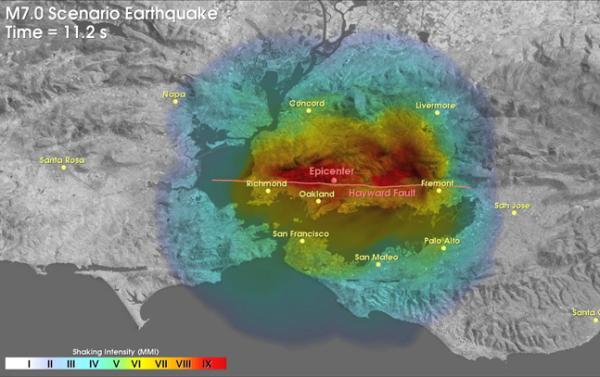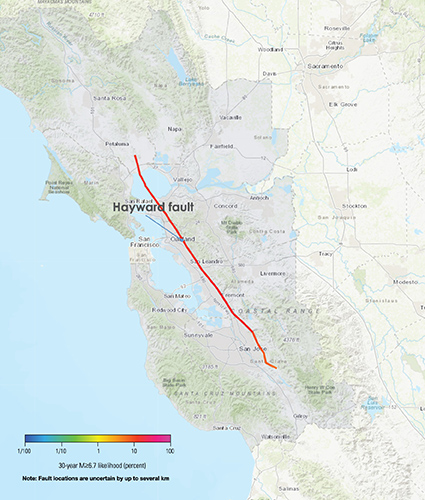The Hayward Fault Threatens Millions in San Francisco Bay Area
Scientists are keeping a nervous eye on the Hayward fault, which runs along the most urbanized edge of San Francisco’s East Bay. The Hayward fault activity is capable of generating destructive earthquakes. This fault, called a “tectonic time bomb,” is about 74 miles long.
History shows that five large earthquakes on the Hayward fault have occurred on average every 150 years—last being in 1868. The Hayward Fault is typically the core concern for experts offering San Francisco Earthquake Predictions, as it’s due for another large earthquake very soon.
- Studies of the fault reveal that it has produced 12 large earthquakes in the past 2000 years spaced 100-220 years apart.
- There is nearly a 3 out of 4 chance of a damaging 6.7 magnitude earthquake in the San Francisco Bay Area in the next 30 years as of 2014.
With the Bay Area population now over 7 million people, nearly 3 million people are living along the fault. According to U.S. Geological Survey (USGS) scientists, the Hayward fault is set to go off anytime now, and much of the region remains vulnerable.
The HayWired Earthquake Scenario
Nearly 3 Million People Living on the Active Hayward Fault
Nearly 3 million people live directly on top of the active Hayward Fault. This includes the communities of Oakland, San Leandro, Hayward, Fremont, Richmond, Castro Valley, Union City and Berkeley.
On April 18, 2018, the USGS presented to the public the Hayward Earthquake Scenario (HayWired), a hypothetical earthquake scenario which imagines a M7.0 earthquake centered in Oakland, California, rupturing the Hayward fault along its length for about 52 miles. As a result, there is strong ground shaking and a range of severe impacts throughout the region.
More than a million homes would be damaged by shaking if the HayWired scenario earthquake were to occur today. Unfortunately, only 10% of Bay Area residents would have the protection of earthquake insurance and the financial strength to recover. All of the cost for residential damage repair and replacement caused by shaking would be out of pocket without earthquake insurance.

Hayward Fault Earthquake Scenario
This scenario shows the ground shaking for a magnitude 7.0 earthquake on the Hayward fault with the epicenter in Oakland, California. In this computer simulation constructed through a collaborative effort between the United States Geological Survey and the Southern California Earthquake Center, the slip or offset across the fault has the earthquake rupture start in Oakland. These scenarios are larger than the magnitude 6.8 Hayward 1868 earthquake, but are about as likely to occur because there has not been a large earthquake on the northern portion of the Hayward fault for about 300 years.
Predicted Effects & Impact of a Major Hayward Fault Earthquake
There is a 3 out of 4 chance of a damaging earthquake in the Bay Area in the next 30 years. USGS names the biggest actors as the San Andreas Fault, the Calaveras Fault, and the Hayward Fault. Bay Area residents also need to be prepared for aftershocks.
Recovery from catastrophic events can take months, even years as proven by the aftermath of Hurricanes Katrina, Sandy, and Maria. Damage to infrastructure, such as transportation and utilities, and other long-term economic effects could substantially increase the losses.
From Fires to Financial Loss: How a Hayward Fault Earthquake Could Devastate Bay Area
Hayward Fault earthquake effects include:
- Financial losses: The estimated financial loss to residential, commercial and infrastructure would be over $100 billion.
- Fires: Lack of firefighting water could turn some of the more than 400 scenario fires into firestorms, burning the equivalent of 80,000 single-family homes in the East Bay and South Bay.
- Water service: In San Francisco and Santa Clara Counties water restoration may take a month. In San Mateo County, it could take up to three months to fully restore the service. And in Alameda and Contra Costa Counties along the Hayward Fault, it might take several months.
- Housing needs: 77,000 to 152,000 households could be displaced.
- Injuries: City of San Francisco Fire Department estimates that, after another major earthquake of 6.8 magnitude, there will be 10 feet of glass in downtown San Francisco on the streets. USGS forecasts 18,000 non-lethal injuries.
- Jobs: A major earthquake along the Hayward Fault would affect more than one-third of current jobs. These include a large number of jobs in healthcare (152,000); professional, scientific, and technical services (222,000); manufacturing (195,000); and retail trade (110,000).
Hayward Fault Line Map - Where is the Hayward Fault?
The San Francisco Bay Area is vulnerable to damaging earthquakes. Find out if you are near the Hayward Fault. Know your risk. Visit the CEA risk map and faults by county.
How to Prepare Your Home if you live near the Hayward Fault
Prepare your home BEFORE an earthquake. Decrease your risk of earthquake damage and injury from an earthquake by identifying possible home hazards:
- Tall, heavy furniture that could topple, such as bookcases, china cabinets, or modular wall units.
- Water heaters that are not up to code by being strapped could rupture.
- Stoves and appliances that could move enough to rupture gas or electrical lines.
- Hanging plants in heavy pots that could swing free of hooks.
- Heavy picture frames or mirrors over a bed.
- Latches on kitchen cabinets or other cabinets that will not hold the door closed during shaking.
- Breakables or heavy objects that are kept on high or open shelves.
- A masonry chimney that could crumble and fall through an unsupported roof.
- Flammable liquids, such as painting or cleaning products, which would be safer in a garage or outside shed.
Consider a seismic retrofit which involves strengthening your home’s foundation to make it more resistant to shaking. CEA offers earthquake home insurance premium discounts for houses and mobilehomes that have been retrofitted. Find out about grants to help for retrofits under the Earthquake Brace & Bolt Program, and the CEA Brace & Bolt program.
Understanding Geologic & Structural Threats
The Hayward Fault activity holds the potential for great devastation. Learn more about Hayward Earthquake Scenario. The Hayward Fault splinters from the Calaveras Fault, an offshoot of the San Andreas Fault, near Hollister. All three faults are right-lateral strike-slip faults. This is a type of shearing force where the right block moves toward you and the left block moves away.
Understand the potential geologic and structural threats to your home in case of a major earthquake by learning your earthquake risk.
The violent shaking from earthquakes can rupture the earth, trigger landslides and turn the surface of the earth to liquid. Your home also may be vulnerable to serious structural damage if it was built before 1979.
Personal Preparedness Guidelines
For an Earthquake along the Hayward Fault, you may get a warning of 10 or 15 seconds, which isn’t very much time. Be prepared with emergency plans, supplies and learn what to do in an earthquake.
Remember to drop, cover, and hold on.
- Drop to the ground. You will be more protected from falling and flying debris.
- Cover. Get under your dining room table or desk. If there isn’t a table or desk near you, cover your face and head with your arms and crouch in an inside corner of the building.
- Hold On. Stay inside and in place until shaking stops. Research has shown that most injuries occur when people inside buildings attempt to move to a different location inside the building or try to leave.
How to Stay Safe
There are two ways people get hurt in California from major earthquakes.
- The first way is that people lose their balance, and they fall—often breaking a wrist, forearm, or hip.
- The second way people get hurt in earthquakes is that things start falling from the ceiling, the walls, and the bookshelves. Most injuries are caused by things falling on you, such as plate glass out of a building, a brick unreinforced masonry façade to a building, or a bookcase inside your home.
Reduce your risk by practicing Drop, Cover, and Hold On. Check out the Seven Steps to Earthquake Safety.
Buying the Right Coverage
Even with the record number of earthquakes that hit California, Californians remain unprepared for the big one. California’s Department of Insurance states that only about thirteen percent of us are prepared with earthquake insurance.
CEA affordable and flexible home earthquake policies:
- Offer choices of coverage and deductibles.
- Protect the investment in your home.
- Provide you with peace of mind when, not if, the big one hits.
Whether you are a homeowner, mobilehome owner, condo-unit owner or renter, find out about how to buy the best choices in earthquake insurance. Home insurance policies and tenant insurance don’t include earthquake coverage. The homeowner or renter needs a separate or companion earthquake policy to cover damages from an earthquake. Get started today with a free estimate.
Premium Discounts
A seismic retrofit involves strengthening your home’s foundation to make it more resistant to shaking. CEA offers earthquake home insurance premium discounts for houses and mobilehomes that have been retrofitted. Find out about grants to help for retrofits under the Earthquake Brace & Bolt Program, and the CEA Brace & Bolt program.
One Stop Shop for Lifesaving Information
CEA spearheaded the creation of an earthquake resource page to make it easy for California residents to access vital information about earthquake preparedness. Our partner organizations, which include entities as diverse as the California Office of Emergency Services (CalOES) and the U.S. Geological Survey (USGS), all play an important role in helping Californians before and after a major seismic event.
Check the website of your favorite local media outlet to see if this valuable resource has already been added. And if it has, be sure to bookmark it for future reference. It’s a one-stop source for information to help you protect your health, your home, and your finances from the inevitable earthquake.
Get an Earthquake Insurance Estimate!
Will you be able to pay for the damages to your home and belongings when the big one strikes? Without CEA’s affordable earthquake residential insurance, you will be responsible for the cost to repair your home and replace your belongings after a major earthquake. Select from 5%-25%deductibles. Find out if earthquake insurance is right for you with a free estimate today.

